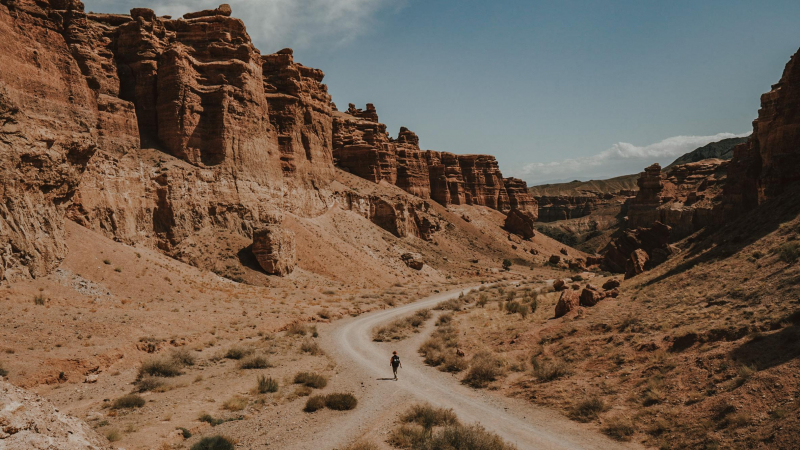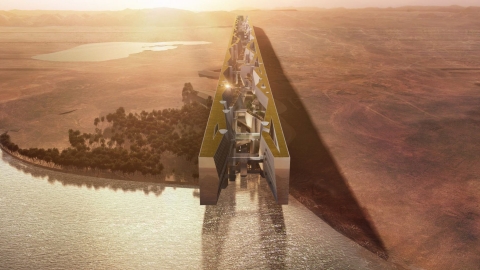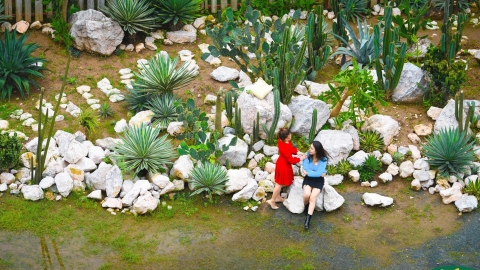This is the journey of Tran Minh Phung, a Vietnamese man with a special passion for strange and harsh lands. This time, he chose Mangystau - a desert in the heart of Kazakhstan as the stopover for his 21-day trip.
Amidst the barren rocky mountains, the mottled dark red ground and the vast space without any trace of life, Phung said he felt like he was walking on Mars. During the nights camping in the Mangystau desert, while looking at the sparkling Milky Way in the pitch black night, that sentence kept echoing in Phung’s head: “If your destination is the moon, then even if you get lost, you are still lost among the stars.”


Step out of the pictures, into the desert
One day, while casually scrolling through Instagram, I was stunned by the photos of Mangystau - a surreal desert land in the heart of Kazakhstan. The scene seemed to belong to another planet - Mars, where the land is mottled with sharp rocks, the arid mountain ranges stretch to the horizon. For a moment, I could only exclaim: "Is this place real, or is it just a product of imagination and a few layers of over-coloring?"


The Mangystan Desert has a surreal and lonely beauty that seems to belong to another planet.
That question kept repeating itself in my head for many days. Until one evening at the end of last year, when everyone was busy preparing for Tet, I quietly booked a ticket, starting a journey that later, I realized it had changed me more than I could have imagined.
For 21 days, I crossed the cold Mangystau Desert, crossed the rugged mountains, and camped beside the blue Eshenkul Lake in the middle of the vast steppe. I believe that even though you can watch thousands of videos, hear hundreds of stories, only when you actually step out there, touch the desert, smell the mountain wind, hear the crackling campfire in the cold night, will everything become truly alive.


In the middle of the Mangystau desert, I found myself on another planet
I woke up just as dawn was touching the edge of the desert. After a quick, frugal breakfast, everyone quietly packed up their things, but their eyes were all on the same direction - Bozzhira, the place considered the "heart" of Mangystau. The road leading there seemed to stretch endlessly across the arid land, with only dust, wind and the color of rocks stretching to the horizon.


The Mangystau Desert is desolate with endless stretches of sand and dust.
Kazakhstan is a country with one of the world’s largest oil reserves, and most of it is located in Mangystau – the most desolate land on the planet. If Kazakhstan is sparsely populated, Mangystau is even more isolated. People joke that here, you can easily see a camel or a scorpion than a human. In the middle of that vast space, the hills, ravines and cliffs seem to be carved by the hands of time, possessing a beauty that is both wild and surreal.
Kyzylkup Hill, or as the locals affectionately call it “tiramisu”, appears with layers of red, yellow, and white soil stacked on top of each other like multi-colored cake layers. When the sun sets, the sunlight covers the hill with a thin layer of honey, making the whole land melt in a brilliant yellow color.

Kyzylkup Hill (also known as Tiramisu cake) with overlapping colored stripes
Then Bozzhira appeared – a canyon so majestic and magical that it felt like I had landed on another planet. Two huge cliffs rose like white horns in the desert, surrounded by a vast chalk valley. As the sun rose, light filtered through the dust, transforming the place into a breathtakingly vivid picture.
Legend has it that hunters once cornered wild animals in the rocky crevices around here, forcing them to rush down the cliffs in panic. That cruel practice is now a memory, left behind after the 1930s.
Bozzhira is considered the symbol of Kazakhstan, a natural wonder that even if you look at the photo a hundred times, you still cannot imagine the overwhelming feeling of standing in the middle of it.

Bozzhira Gorge - one of the natural wonders and symbol of Kazakhstan
Not far away is Bokty Mountain - "the sleeping cavalryman". The flat-topped mountain stands tall in the desert, like a giant sculpture carved from the sky. The Kazakh people proudly call Bokty the soul of the country, its image is even printed on the 10,000 tenge banknote. Although I only had three days in Mangystau, I was lucky to witness with my own eyes the transformation of the rock color through every moment of the day.

Bokty Mountain - image featured on Kazakhstan's 10,000 tenge note
At the end of the journey, the Valley of the Spheres (Torysh) appeared in the cold wind. Hundreds of round stones were scattered all over the ground, as if someone had dropped giant meteorites from space. The locals called them “Koitas”. Some joked that they were dinosaur eggs, others believed they were traces of aliens. Scientists have not yet found the exact answer, only knowing that they have existed here for millions of years, silently in the desert.
I lay down in the middle of that valley, feeling as if I had just been lost in another world. The Kazakh sky was deep blue, the wind whistled through the crevices of the rocks like an echo of the universe. In that moment, I remembered the dialogue in the movie Interstellar: “Father, I have completed my mission and returned. But I could not find you and my vast Kazakh steppe, I could only land in a strange land…” And perhaps, Mangystau was that strange place, but it made me feel like I had belonged there for a long time.

Valley of the Spheres (Torysh feels like the surface of the Moon)
In the middle of the Mangystau desert, life becomes “obvious”
Mangystau is a land of extremes: scorching summers, bitterly cold winters, and barely a drop of rain year-round. If you want to avoid the sun, you should come in spring (April-May) or autumn (September-October), when the climate is milder and the wind blows gently through the rocky mountains. I went in late June, during the hottest days: midday temperatures rose above 40 degrees Celsius, nights were chilly, and early mornings had dew on the grey rocks.
Some people say that only by going to the desert alone can you truly feel its loneliness. But Mangystau is not a place to be reckless. There are almost no signals, landmarks are erased by wind and sand, and getting lost is only a matter of time. I chose to go with a small group, hired a local guide and a specialized Jeep. They took care of everything from drinking water, food, and tents, seemingly small things but essential for survival in this arid place.

The moment of conquering Mangystau - "Mars" in the heart of Kazakhstan
Four days without bathing, my skin was sunburned, my lips were dry and cracked, and I was exhausted from the sun and wind. But it was there, in the quiet space, looking at the sky filled with falling stars above the top of Bozzhira, that I realized the feeling that the city could not give me. Not living slowly, but living clearly with each breath, each drop of water, each step imprinted on the red soil.

 VI
VI EN
EN



































